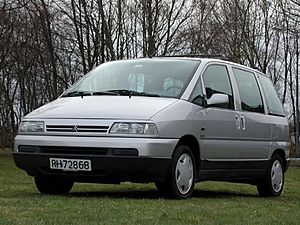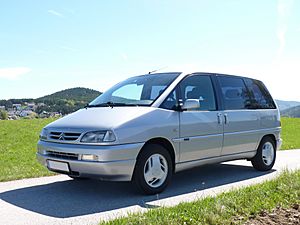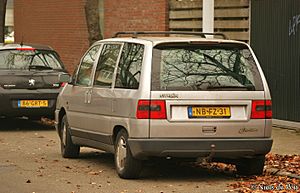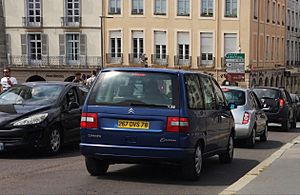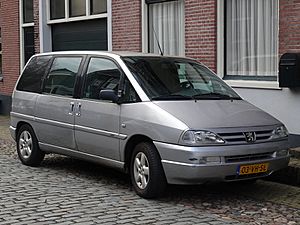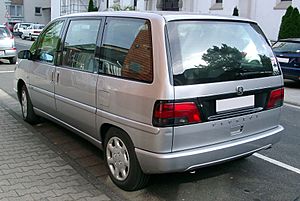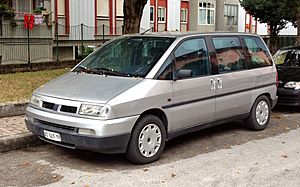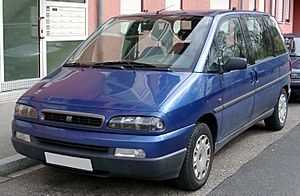Eurovans facts for kids
The Eurovans are a group of family cars made by Citroën, Peugeot, Fiat, and Lancia. These cars were all built in the same factory in France, called Sevel Nord. Even though the car companies didn't use the name "Eurovan" themselves, car experts and journalists used it to talk about these cars together.
The first Eurovans came out in March 1994. Fiat and Lancia stopped making their versions in November 2010, and Citroën and Peugeot stopped in June 2014. These cars are known as large MPVs, which stands for Multi-Purpose Vehicles. They are designed to carry many passengers comfortably.
The Eurovans look and work very similarly. This is a good example of "badge engineering", where different brands sell almost the same car with small changes like different badges or grilles. They share many parts with the Citroën Jumpy, Fiat Scudo, and Peugeot Expert vans.
The first Eurovans were called the Citroën Evasion (or Synergie in the UK), Fiat Ulysse, Lancia Zeta, and Peugeot 806. For the second generation, most names changed. They became the Citroën C8, Lancia Phedra, and Peugeot 807. Only the Fiat Ulysse kept its name.
Quick facts for kids Eurovans |
|
|---|---|
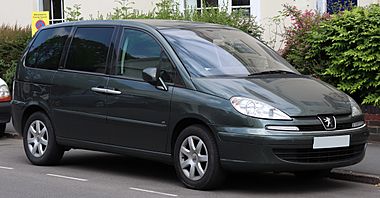
Peugeot 807 (facelift), one of the four Eurovan versions
|
|
| Overview | |
| Manufacturer | Sevel Nord |
| Production | March 1994 – June 2014 |
| Assembly | France: Lieu-Saint-Amand (Sevel) |
| Body and chassis | |
| Class | Large MPV (M) |
| Body style | 5-door MPV |
| Layout | Front-engine, front-wheel-drive |
| Related | Sevel Nord vans |
| Chronology | |
| Successor | For FCA: Fiat Freemont Lancia Voyager Fiat Ulysse (Ulysse Nameplate) For PSA: Citroën Space Tourer/Peugeot Traveller Citroën Grand C4 Picasso Peugeot 5008 II |
Contents
First Generation (1994–2002)
| First generation | |
|---|---|
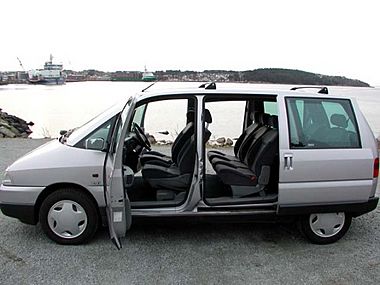
1998 Citroën Evasion
|
|
| Overview | |
| Also called | Citroën Evasion Citroën Synergie Fiat Ulysse Lancia Zeta Peugeot 806 |
| Production | March 1994 – September 2002 |
| Body and chassis | |
| Platform | Sevel Nord vans |
The first Eurovans were launched in June 1994. They were smaller than some American vans, like the Chrysler Voyager. Like many minivans, they had sliding doors on the sides for easy access. Even though other vans came in longer versions, the Eurovans were only made in one size.
These Eurovans looked almost the same. The main differences were in their front grilles, taillights, wheel designs, and the brand badges. In October 1998, they got a small update, which is called a "facelift". This usually means minor changes to the car's appearance.
Inside, the gear stick was placed on the dashboard, not on the floor. The handbrake was next to the driver's seat, near the door. This design created more space between the front seats. The cars could have two front seats, three removable seats in the middle row, and two or three more removable seats in the back.
Engines
The first Eurovans used different types of engines, including both petrol and diesel options. These engines were paired with a five-speed manual gearbox. Some petrol models also offered an automatic gearbox.
Model Differences
Citroën Evasion
The Evasion was called Synergie in the United Kingdom and Ireland, where cars drive on the right side of the road. However, it kept the Evasion name in New Zealand. In October 1998, the Citroën Evasion received a small update. This included a bigger Citroën logo and changes to the front grille and back bumper. More than 120,000 Evasion/Synergie cars were made.
Peugeot 806
The 806 followed Peugeot's naming system. The first number shows the car's size, and the last number shows its generation. The "8" meant it was a larger car, and the "6" meant it was part of the "x06" generation of Peugeot cars.
Fiat Ulysse
The Fiat version was named after Ulysses, a famous hero from ancient Greek stories. Just like the other Eurovans, the Ulysse also got a facelift in October 1998.
Lancia Zeta
Lancia named its version the Zeta, using a letter from the Greek alphabet. The Lancia Zeta was considered the most luxurious Eurovan. It had a big chrome grille and was very well-equipped. It was also more expensive than the other versions. The Zeta was not sold in the UK.
Second Generation (2002–2014)
| Second generation | |
|---|---|
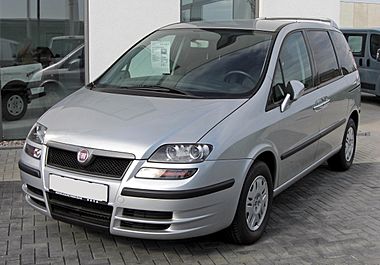
Fiat Ulysse (second generation)
|
|
| Overview | |
| Also called | Citroen C8 Peugeot 807 Fiat Ulysse Lancia Phedra |
| Production | October 2002 – June 2014 (Citroën and Peugeot) September 2002 – November 2010 (Fiat and Lancia) |
| Designer | Centro Stile Lancia and Centro Stile Fiat |
| Body and chassis | |
| Platform | Sevel Nord vans |
| Dimensions | |
| Wheelbase | 2,823 mm (111.1 in) |
| Length | 4,727 mm (186.1 in) (Peugeot 807) 4,750 mm (187.0 in) (Lancia Phedra) |
| Width | 1,854 mm (73.0 in) (Peugeot 807) 1,863 mm (73.3 in) (Lancia Phedra) |
| Height | 1,752 mm (69.0 in) (Peugeot 807) |
| Weight |
|
In 2002, the second generation of Eurovans was released. The Peugeot 807 came out in June, followed by the Citroën C8 in July. The main structure of the car stayed the same, but the overall size of the car grew. It became almost 30 cm longer, which made the inside much roomier. The new Eurovans had a more modern, rounded look and a new dashboard with gauges in the middle.
The differences between the brands were more noticeable this time. Each car had unique front and back designs, including different headlights and taillights. The interior colors also varied. The middle and back seats could now slide forward and backward, making them more flexible. You could also get a three-person bench seat for the very back row.
The Fiat and Lancia versions were a bit wider than the Citroën and Peugeot vans. The Lancia Phedra was also longer than the other Eurovans. The Citroën C8 and Peugeot 807 received two small facelifts, one in 2008 and another in 2012.
Engines
The second generation also used various petrol and diesel engines. These engines were usually paired with a five-speed manual or a four-speed automatic gearbox. Later, a six-speed manual option became available in some models. The most powerful versions even had a V6 petrol engine.
All diesel engines were called "HDi" by Citroën and Peugeot, but Fiat models used the "JTD" name for the same engines.
Model Differences
Citroën C8
Citroën decided to rename its minivan to fit its new naming style. This style used "Cx" where "x" was a number showing the car's size. So, the minivan became the Citroën C8.
Peugeot 807
The 807 was the replacement for the earlier 806 model.
Fiat Ulysse
Fiat kept the Ulysse name for its second-generation model. The car that came after the Fiat Ulysse was the Fiat Freemont.
Lancia Phedra
Lancia named its new minivan the Phedra. This name comes from a character in Greek mythology. The car that replaced the Lancia Phedra was the Lancia Voyager.
Images for kids
See also
 In Spanish: Eurovan (Sevel) para niños
In Spanish: Eurovan (Sevel) para niños


